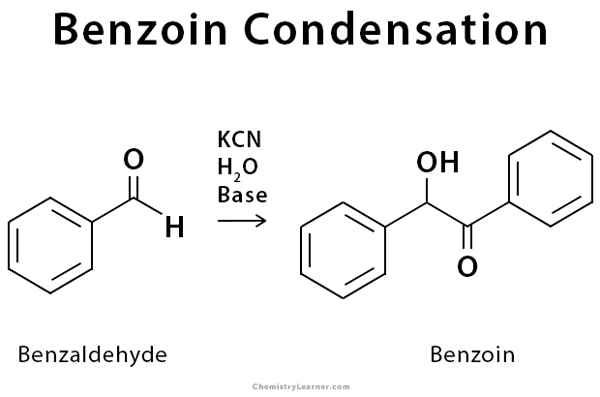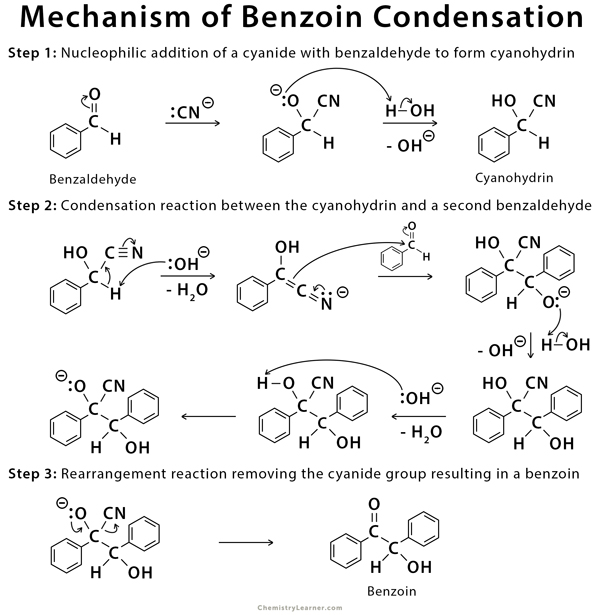Benzoin Condensation
Definition: What is Benzoin Condensation?
The benzoin condensation is the condensation between two molecules of benzaldehyde to form benzoin in the presence of a cyanide catalyst (e.g., NaCN and KCN) or thiamine (vitamin B). The structure of benzoin is that of a ketone. It consists of acetophenone bearing hydroxy and phenyl substituents at the alpha-position (α‐hydroxyl ketone). Its IUPAC name is 2-hydroxy-1,2-diphenylethanone with a molecular mass of 212.24 g/mol. A cyanide ion usually catalyzes benzoin condensation. Cyanide is used because it is a good nucleophile, can stabilize the intermediate ion, and is an excellent leaving group. Condensation reactions are called dehydration synthesis reactions because dehydration involves loss of water, while synthesis means producing new compounds [1-4].
The history of this reaction goes back to 1832 when it was reported by German scientists Justus von Liebig and Friedrich Wöhler.
Mechanism of Benzoin Condensation
The standard method for performing the benzoin condensation begins with benzaldehyde treated with a catalytic amount of sodium cyanide in the presence of a base. The cyanide ion forms a stable cyanohydrin intermediate. This step is followed by a condensation reaction in which the cyanohydrin reacts with a second mole of benzaldehyde. The final product is benzoin [1-5].
Uses and Applications of Benzoin Condensation
The benzoin condensation reaction has applications in various organic synthesis and reactions.
- Benzoin is made use in the hardening of different polymers by making use of microemulsion.
- The reaction is helpful in the synthesis of heterocyclic compounds and also extends to the aliphatic form of aldehydes.
- The reaction also finds its application in the organic chemistry for the production of polymers as well in the condensation of new monomers.
- Benzoin can be oxidized with nitric acid to give benzil, which is used in the free-radical curing of polymer networks.
Thiamine Catalyzed Benzoin Condensation
The highly toxic cyanide ion catalyzes several biochemical reactions like that of the benzoin condensation. It was proposed that thiamine can function in a purpose completely analogous to cyanide in initiating these biochemical reactions as well as the benzoin condensation. Sodium hydroxide (NaOH) is added to thiamine hydrochloride (C12H18Cl2N4OS) to form free thiamine. Thiamine, also known as vitamin B1, is a colorless compound with the chemical formula C12H17N4OS. The resonance-stabilized conjugate base of the thiazolium ion, thiamine, and the resonance stabilized carbanion (C) that it forms, are the primary compounds of the reaction. Like the cyanide ion, the thiazolium ion also has just the right balance of nucleophilicity, ability to stabilize the intermediate anion, and good leaving group qualities [6,7].
References
- Definition and mechanism – Organic-chemistry.org
- Definition and mechanism – Chem.latech.edu
- Definition and mechanism – Ias.ac.in
- Definition and mechanism – Onlinelibrary.wiley.com
- Mechanism – Researchgate.net
- Thiamine Catalyzed – Chtf.stuba.sk
- Thiamine Catalyzed – Organicchemistrytutor.com








Write the characteristics, stability and formation of free radicals.
There are no free radicals in this reaction. If you are referring to the reaction intermediate, it is very stable.